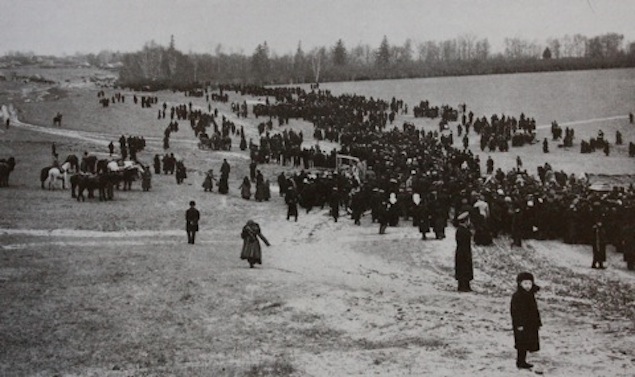Leisure • Literature
Leo Tolstoy
Leo Tolstoy was a believer in the novel not as a source of entertainment, but as a tool for psychological education and reform.
It was, in his eyes, the supreme medium by which we can get to know others, especially those who might from the outside seem unappealling, and thereby expand our humanity and tolerance.
He was born in 1828 at Yasnaya Polyana, a huge family estate, a hundred miles south of Moscow. It was to be his home, on and off, for the rest of his life.
His parents died when he was young and he was brought up by relatives. He flopped at university. One lecturer described him as being “unable and unwilling to learn.”
Tolstoy at age 20, 1848
He spent a few years gambling and drinking and chasing gypsy women, before signing on as an artillery officer in the Crimean War.
He got married in his early thirties. His wife Sophia, who came from a sophisticated, high-cultured background, was only eighteen. They had thirteen children, nine of whom survived infancy.
Sophia and their daughter Alexandra
It was a difficult marriage; there were huge arguments about sex and bitterness on both sides. Leo grew a very long beard, became a fitness fanatic and spent most of his time in his study.
What he did there was to write several hugely successful books, among them, War and Peace, Anna Karenina and The Death of Ivan Ilych.
Tolstoy with his family
Tolstoy did not believe in the idea of art for art’s sake. He was deeply invested in the belief that good art should make us less moralistic and judgemental and should be a supplement to religion in terms of developing our reserves of kindness and morality. This crusading moralistic side of Tolstoy has often been ignored by modern critics – who don’t wish to dirty art with a mission – but it is in fact the most important side of Tolstoy, and none of his efforts can properly be appreciated without keeping it in mind.
Tolstoy’s first great novel was War and Peace, published in 1869, when he was 41. In it, we meet Natasha Rostov, a delightful, free-spirited, young woman.
At the start, she is engaged to Andrey, a kind and sincere man who loves her deeply but is also rather emotionally remote and avoidant. While Andrey is away travelling in Italy, Natasha meets a handsome cynical waster called Anatole and falls under his spell. He almost manages to seduce her and persuades her to run away with him, though her family manage to stop her at the last minute. Everyone is appalled and furious with Natasha. This sort of madness wrecks her own prospects and deeply shames her family.
By the world’s standards, Natasha has failed terribly. If we encountered a news clip about such a person we might rapidly come to the conclusion that she lies beyond the range of normal sympathy. She had so much; she thought only of herself, she got what she deserved.
And yet Tolstoy’s view is that if we grasp what things are like for Natasha inside her mind, we can’t and won’t withdraw our sympathy. She isn’t in truth self-indulgent, frivolous or totally lacking in devotion. She’s just a sexually inexperienced young woman who feels abandoned by her preoccupied boyfriend. She is someone who has a deeply impulsive and warm nature and is easily carried away by joy and happiness. She is also acutely worried about letting other people down, which is what leads her into trouble with the scheming and manipulative Anatole.
Tolstoy keeps us on Natasha’s side and by doing so, he is getting us to rehearse a move he believes is fundamental to an ethical life: if we more accurately saw the inner lives of others, they couldn’t appear to us in the normal cold and one-dimensional was – and we would treat them with the kindness which they truly need and deserve. No one should be outside the circle of sympathy and forgiveness.
For Tolstoy, a particular task of the novel is to help us to understand the so-called ‘dislikeable’ characters. One of the most initially repellant characters in his fiction is the husband of Anna Karenina, the heroine of his great novel of the same name, the pompous and stiff Karenin. The novel, a tragedy, tells the story of the beautiful, clever, lively and very generous hearted married Anna, whose life falls apart when she falls in love with Vronsky – a splendid young cavalry officer.
Anna’s husband – Count Alexei Alexandrovich Karenin – is a fussy, status conscious, mannered high-ranking government official, who is often callous towards Anna and is unable to answer any of her emotional yearnings. As Anna’s affair with Vronsky develops, her husband’s main worry is that it might lead to social gossip which could undermine his public standing. He appears to have no feelings at all about the marriage itself. He comes across as simply cold and brutish.
But then Anna gives birth to her lover’s child, she is ill, and – in a highly touching scene – Karenin is deeply moved, weeps for the infant, for the mother, and forgives Anna:
‘No, you can’t forgive me!’ [says Anna]. And yet he suddenly felt a blissful spiritual condition that gave him all at once a new happiness he had never known: a glad feeling of love and forgiveness for his enemies filled his heart. He knelt down, and laying his head in the curve of Anna’s arm; he sobbed like a little child.’
The hitherto cold Karenin falls in love with Anna’s baby:
For the little newborn baby he felt a quite peculiar sentiment, not of pity only, but also of tenderness. At first, from a feeling of compassion alone, he had been interested in the delicate little creature… Now he would go into the nursery several times a day… Sometimes for half an hour at a stretch he would sit silently gazing at the downy, wrinkled face of the sleeping baby, watching the movements of the frowning brows, and the fat little hands, with clenched fingers, that rubbed the little eyes and nose.
Thanks to the judicious Tolstoy, we see entirely unexpected aspects of the man. His inner life is not at all what we would expect, judging from the outside. But Tolstoy’s point is that Karenin is not really an exceptional character in this respect. He is just the normal mixture of bad and very good. It is highly usual for rather off-putting people to have huge reserves of buried tenderness: to have dimensions to their characters very different from and often much nicer than those that their forbidding appearance suggests.
We are invited on a comparable journey in relation to another character in Tolstoy’s fiction, the hero of the The Death of Ivan Illych (published in 1886). At the start of the novel, we meet Ivan, a high court judge at the pinnacle of society who appears selfish, vain and cynical. But one day, while helping hang some curtains, Ivan falls from a ladder and becomes aware of an inner pain which is the first sign of a disease which is soon diagnosed as fatal. He will have just a few months left to live. As his health declines, Ivan spends a lot of time sitting on the sofa at home.
His family, aware at just how inconvenient his death will be to their social and financial standing, begin to resent him and his illness. He’s short and ill-tempered back. And yet inside, Ivan is going through a range of epiphanies. He looks back over his life and atones for its shallowness. He becomes newly sensitive to nature – and to the ordinary kindness of his manservant, a humble uneducated man of peasant stock. He grows furious at the stupid way in which everyone avoids paying attention to the one really crucial fact about life: that we all die. He realises that our mortality should be constantly before our minds and should inspire continual kindness and sympathy. As he dies, Tolstoy imagines him finally feeling pity and forgiveness for all those around him.
As is typical in his writing, Tolstoy recounts in detail the vast philosophical and psychological dramas going on inside his hero’s head. All that those around him – the doctors and his family – get to see is a sullen man who spends a lot of time with his face to the wall, who is always saying ‘go away, leave me alone’ and who at times howls with misery, yet we can see a visionary, a prophet and a man of outstanding moral courage and generosity. In writing about Ivan, Tolstoy wanted us to see his life as representative of all human potential, if only we could wake up to it before it is too late.
**
When he was about seventy, Tolstoy pulled together his thinking about being a writer in a long essay, What is art?
It is one of his most important books. In it, Tolstoy proposes that art has a great mission. Through great art, he tells, us ‘Lower feelings – less kind and less needed for the good of humanity – are forced out and replaced by kinder feelings which better serve us individually and collectively. This is the purpose of art.’
As a supremely skilled and seductive writer, Tolstoy knew that novels need to be entertaining, or we simply won’t bother to read them. But he was also convinced that they have to aspire to be something else as well: key supports for our own stumbling path to maturity and kindness. And they can do this because they are able to get into a place we need but rarely have access to: the inner lives of other people.
In What is art?, Tolstoy was mostly writing about the works of other authors, but it is really his own achievement that he is, indirectly and modestly, summing up. Great writers shouldn’t ever be just helping their readers pass the time. Their writing must be a form of therapy, an attempt to educate us towards emotional health and ethical good sense.
As they aged, the tensions between Leo and and his wife Sophia grew. He complained that they had “totally opposite ideas of the meaning of existence”. Ye he insisted that even as Sophia “grew more and more irritable, despotic and uncontrollable” he continued to love her, though he admitted that he had given up trying to express his feelings. “There is no greater tragedy than the tragedy of the marital bed”, he wrote. Finally, when he was past eighty, Tolstoy couldn’t take it any more, and deserted his wife and family. He ran away in the middle of a freezing November night, caught pneumonia and died at the nearby railway station, where he was waiting for a train.
Tolstoy’s funeral was a major public occasion. Thousands showed up from across Russia and the world.
This was fitting, for his central proposal has enormous social implications. He realised that our picture of what other people are like is a great driving force of relationships, economics and politics. He held up the tantalising idea that art could be the major vehicle for getting more accurate – and often much kinder – ideas about what is going on in the minds (and lives) of others.
His body was taken back to his house and buried in the garden, under some trees where he liked to play as a child.

































